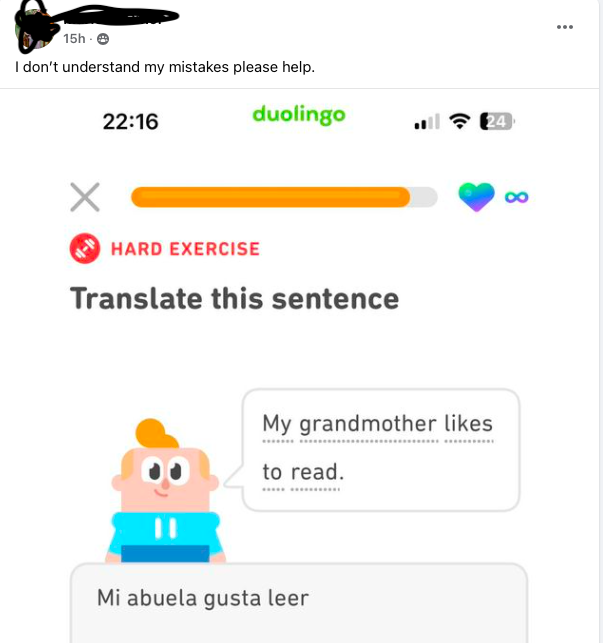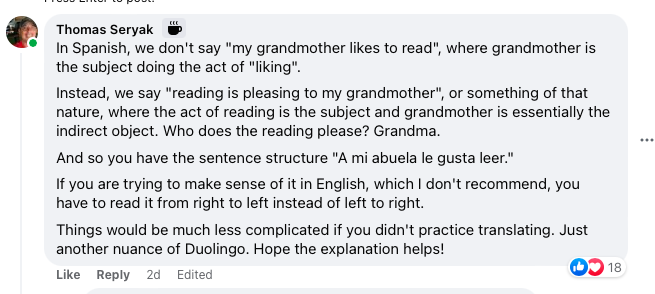If you’re looking for an explanation of how the verb “gustar” works in Spanish – you’re in the right place.
My Grandma Likes to Read
Recently, a Spanish learner posted a question on the Facebook page “Learning Spanish” about why her answer to a Duolingo exercise was incorrect:

Here was my response:

Let’s take a deeper look into my explanation for how we talk about things we like in Spanish.
The Left Side
The best way to understand how the verb “gustar” (and other verbs like it) work is to look at it as two parts – the left side and the right side.
First, we draw a line between “le” and “gusta”. “Le” is an indirect pronoun and determined by whatever comes before it in the sentence, in this case “a mi abuela”. Grandma is WHO receives the pleasure from reading.

The indirect pronoun will change depending on who receives the action as seen here in this chart:
| A mi | ME | A nosotros/-as | NOS |
| A ti | TE | A vosotros/-as | OS |
| A él/ella/usted | LE | A ellos/ellas/ustedes | LES |
Keep in mind that the left side of the line has NOTHING to do with the right side of the line. Take a look:
| A mi me | gusta leer. | I like to read. |
| A ti te | gusta leer. | You like to read. |
| A él/ella/usted le | gusta leer. | He/she/you(formal) likes to read. |
| A nosotros/-as nos | gusta leer. | We like to read. |
| A vosotros/-as os | gusta leer. | You all like to read. |
| A ellos/ellas/ustedes les | gusta leer. | They like to read. |
*Try This*
Since the left side of a gustar phrase is never impacted by what happens on the right side, try repeated out loud 30 times each line in the table above.
Say “A mi me…” 30 times, followed by “A ti te…” 30 times, “A él le…” 30 times, etc.
This will help train your brain to always get the left side right and help you avoid saying things like, “A ella les gustan los postres.”
The Right Side
The right side of the line functions independently from the left side and is determined by what comes after it in the thought/sentence, thus requiring a bit of foreshadowing. You have to know what comes after the verb gustar to know whether to gusta or gustan.
Gustar Followed by a Verb
If what follows the verb gustar is another verb, the verb is treated like an “it” – third person singular, and therefore conjugates the gustar accordingly – gusta.

“Leer”acts as the subject doing the action of pleasing. If that is confusing, try reading the right side backwards. Leer –> gusta. Reading pleases.
To illustrate that the right side functions independent from the left, keep reading.
Gustar Followed by a Singular Noun
If a singular noun follows gustar like “el libro”, then we treat “el libro” as the subject that determines how “gustar” will be conjugated.
Since “el libro” is an “it” or third person singular, the conjugation is – gusta.
Reading right to left instead of left to right: El libro –> gusta. Take a look:
| A mi me | gusta el libro. | I like the book. |
| A ti te | gusta el libro. | You like the book. |
| A él/ella/usted le | gusta el libro. | He/she/you(formal) likes the book. |
| A nosotros/-as nos | gusta el libro. | We like the book. |
| A vosotros/-as os | gusta el libro. | You all like the book. |
| A ellos/ellas/ustedes les | gusta el libro. | They like the book. |
Notice how the middle column does not change. It doesn’t matter who likes the book because the “who” isn’t the subject doing the action – it’s the book that’s doing the action of pleasing; therefore, the phrase or thought will always end with “gusta el libro”.
Gustar Followed by a Plural Noun
If a plural noun follows gustar like “los libros”, then we treat “los libros” as the subject that determines the conjugation of “gustar”.
Since “los libros” is a plural “it” or third person plural, the conjugation is “gustan”. Reading right to left: Los libros –> gustan. Take a look:
| A mi me | gustan los libros. | I like books. |
| A ti te | gustan los libros. | You like books. |
| A él/ella/usted le | gustan los libros. | He/she/you(formal) likes books. |
| A nosotros/-as nos | gustan los libros. | We like books. |
| A vosotros/-as os | gustan los libros. | You all like books. |
| A ellos/ellas/ustedes les | gustan los libros. | They like books. |
Once again, the middle column does not change. The conjugation of the verb “gustar” is determined in this case by “los libros”, so it doesn’t matter WHO likes books because the books act as the subject doing the action.
*Try This*
Write out a list of singular and plural nouns along with the correctly conjugated version of gustar and then read the list out loud.
Example list of singular nouns with gustar:
- gusta la camisa
- gusta la casa
- gusta la música
- gusta el mensaje
- gusta el color
- etc.
Example list of plural nouns with gustar:
- gustan las películas
- gustan los gatos
- gustan las frutas
- gustan los animales
- gustan los zapatos
- etc.
This exercise should help you automate the right side of a gustar phrase.
Ready to try putting the whole phrase together? Here’s a step-by-step process to help you out.
Step by Step Process
- Start your thought with to whom the thing pleases. “A mi, a ti, a ella, etc.”
- Add the corresponding indirect object pronoun me/te/le/nos/os/les.
- Conjugate “gustar” based on what comes after it (in Step 4 – verb, singular or plural noun).
- Finish the thought with what does the pleasing.
- Put it all together.
Let’s do one together.
How would you say, “we like the beach” in Spanish?
Step 1 – A nosotros/-as
Step 2 – A nosotros/-as + nos
Step 3 – A nosotros/-as + nos + gusta (because “la playa”)
Step 4 – A nosotros/-as + nos + gusta + la playa.
Step 5 – “A nosotros nos gusta la playa.“
Let’s do another one.
How would you say, “María doesn’t like cats” in Spanish?
Step 1 – A María
Step 2 – A María + (no) le
Step 3 – A María + no le + gustan (because “los gatos”)
Step 4 – A María + no le + gustan + los gatos
Step 5 – A María no le gustan los gatos.
Do you have time for one more?
Isn’t this fun? How would you say, “Do you like romantic songs?” in Spanish.
Step 1 – A ti
Step 2 – A ti + te
Step 3 – A ti + te + gustan (because “las canciones”)
Step 4 – A ti + te + gustan + las canciones románticas
Step 5 – ¿A ti te gustan las canciones románticas?
Want some more practice? Here’s a little quiz:
Gustar Quiz
#1. A ellas ___ gusta la clase de español.
#2. A ti __ gustan los deportes.
#3. A mi __ gustan los gatos.
#4. A los estudiantes ___ gusta jugar Kahoot.
#5. A María __ gustan los vegetales.
#6. A nosotros ___ gusta la comida mexicana.
#7. A Roberto __ gustan las frutas.
#8. A ustedes ___ gusta dibujar.
#9. A Pablo y yo ___ gusta tocar el piano.
#10. ¿A ti te _____ los vegetales?
#11. A ella no le ______ estudiar español.
#12. A mi no me ______ las cebollas.
#13. A nosotros nos _____ jugar baloncesto.
#14. A ellos les _____ la comida china.
#15. ¿A ti te _____ comer vegetales?
Results
Keep working on it!
Was this the best explanation of how the verb gustar works you’ve ever seen?
Please consider sharing it on your social media accounts, and if you have other topics you’d like to hear about, leave me a message in the comments section. ¡Hasta pronto!


1 Pingback